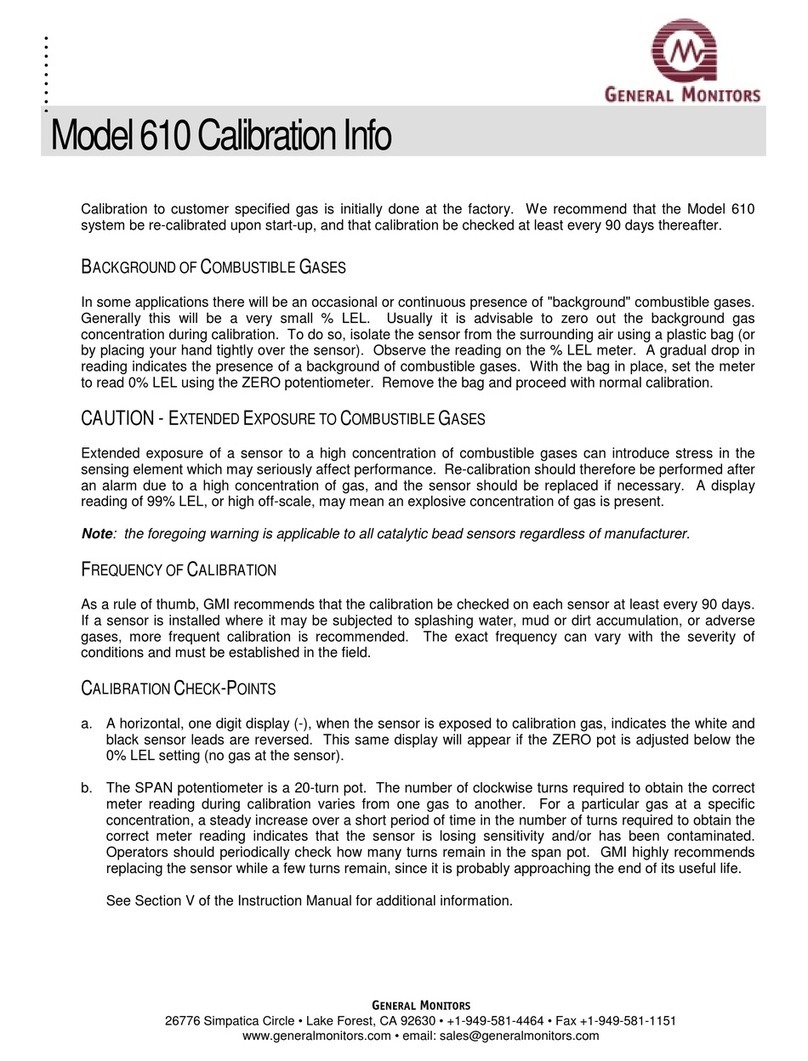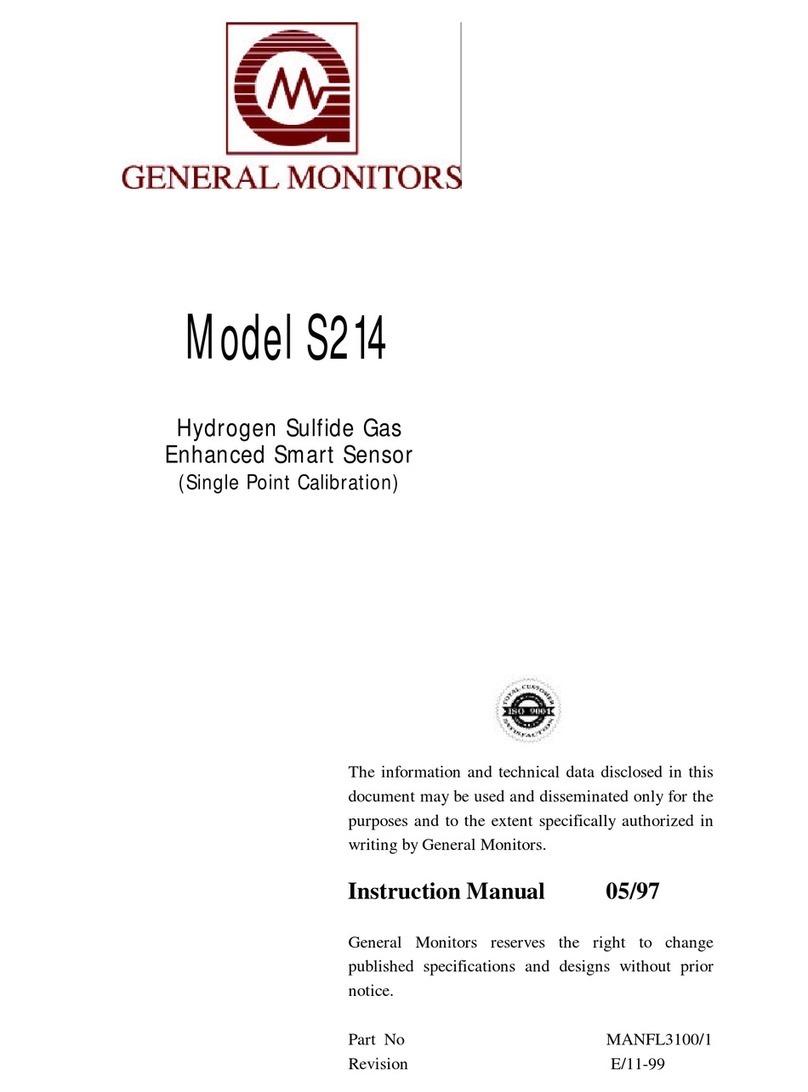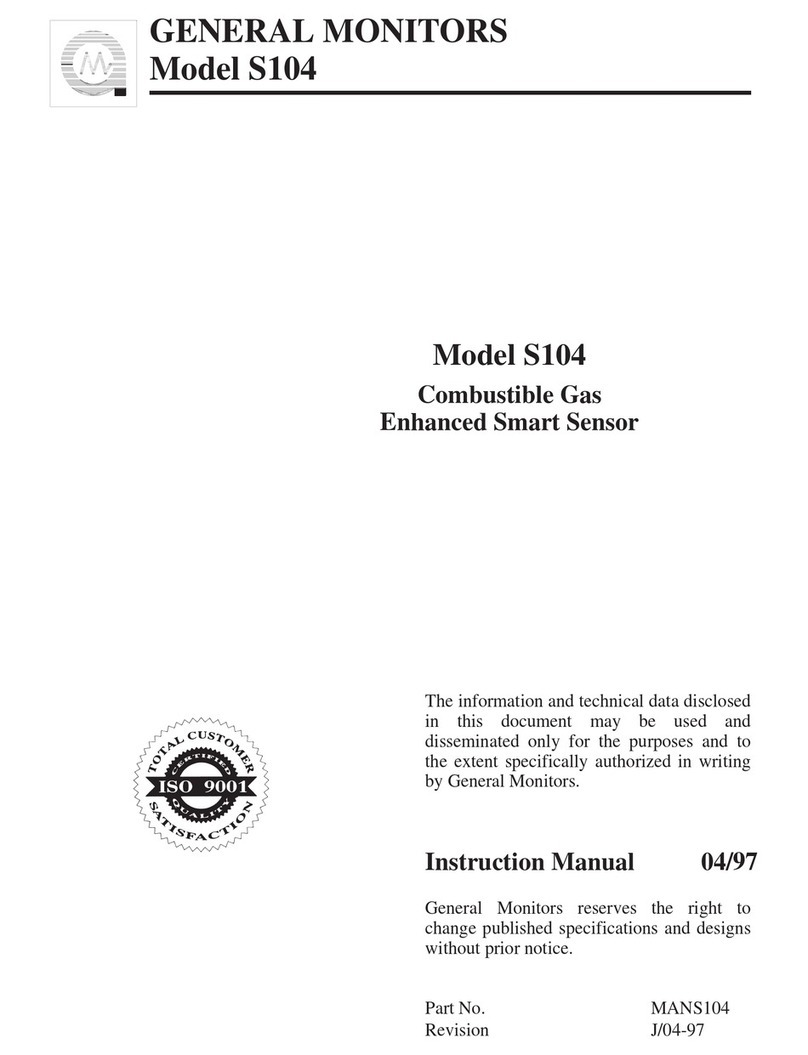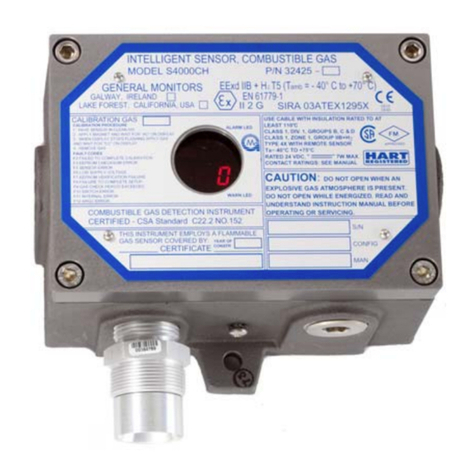General Monitors S4000C User manual

Model S4000C
Intelligent Sensor for
Combustible Gas Detection
The information and technical data disclosed in
this document may be used and disseminated
only for the purposes and to the extent
specifically authorized in writing by General
Monitors.
Instruction Manual 0307
General Monitors reserves the right to change
published specifications and designs without
prior notice.
MANS4000C
Part No. MANS4000C
Revision G/03-07

S4000C
ii
This page intentionally left blank

S4000C
iii
3.5 Terminal Connections................................................................................................................7
Table of Contents
TABLE OF FIGURES..................................................................................................................VI
TABLE OF TABLES...................................................................................................................VII
QUICK START GUIDE.................................................................................................................1
Mounting and Wiring...............................................................................................................................1
Tools Required...........................................................................................................................1
Terminal Connections.............................................................................................................................1
1.0 INTRODUCTION ....................................................................................................................1
1.1 Protection for Life.......................................................................................................................1
1.2 Special Warnings.......................................................................................................................1
1.3 System Integrity Verification ......................................................................................................1
2.0 PRODUCT DESCRIPTION.....................................................................................................3
2.1 General Description ...................................................................................................................3
3.0 INSTALLATION......................................................................................................................4
3.1 Receipt of Equipment.................................................................................................................4
3.2 Tools Required...........................................................................................................................4
3.3 Choosing Product Locations......................................................................................................4
3.3.1 Remote Mounting of the Sensor from the Electronics..................................................5
3.4 Mounting and Wiring..................................................................................................................5
3.5.1 Terminal Block TB1 – Sensor Connections..................................................................7
3.5.2 Terminal Block TB2 – Power and Signal Connections.................................................7
3.5.3 DC Power and Ground Connections.............................................................................8
3.5.4 Analog Signal Connections...........................................................................................9
3.5.5 Terminal Block TB3 – Relay Connections ..................................................................10
3.5.6 European Union (EU) Approved Applications.............................................................11
3.5.7 Cable Termination in the Non-Hazardous Area..........................................................11
3.6 Maintaining the X/P Integrity....................................................................................................12
4.0 OPERATION.........................................................................................................................13
4.1 Start-Up Checklist....................................................................................................................13
4.2 Start-Up....................................................................................................................................13
4.3 Relay Reset..............................................................................................................................13
4.4 User Selectable Options ..........................................................................................................14
4.4.1 Model S4000C User Menu Structure..........................................................................15
4.4.2 Calibration Level .........................................................................................................15
4.4.3 Warning Relay Settings ..............................................................................................16
4.4.4 Alarm Relay Settings...................................................................................................16
4.4.5 MODBUS Channel 1 Settings.....................................................................................17
4.4.6 MODBUS Channel 2 Settings.....................................................................................17
4.5 Gas Check Mode .....................................................................................................................18
4.5.1 Procedure for Checking the Calibration......................................................................18

S4000C
iv
8.0 MODBUS INTERFACE ........................................................................................................26
4.6 Calibration................................................................................................................................18
4.6.1 Calibration Procedure .................................................................................................19
4.6.2 Aborting Calibration.....................................................................................................20
4.6.3 Adjustable Calibration Level .......................................................................................20
4.6.4 Remaining Sensor Life................................................................................................20
4.6.5 Initializing the Remaining Sensor Life.........................................................................20
4.7 Calibration Equipment..............................................................................................................21
4.7.1 Portable Purge Calibrator ...........................................................................................21
5.0 MAINTENANCE ...................................................................................................................22
5.1 General Maintenance...............................................................................................................22
5.2 Storage.....................................................................................................................................22
6.0 TROUBLESHOOTING .........................................................................................................23
6.1 Fault Codes & Their Remedies................................................................................................23
6.1.1 F2 Failed to Complete Calibration ..............................................................................23
6.1.2 F3 EEPROM Checksum Error....................................................................................23
6.1.3 F4 Sensor Error...........................................................................................................23
6.1.4 F5 Unused...................................................................................................................23
6.1.5 F6 Low Supply Voltage...............................................................................................24
6.1.6 F7 EEPROM Verification Failure ................................................................................24
6.1.7 F8 Failure to Complete Setup.....................................................................................24
6.1.8 F9 Gas Check Period Exceeded.................................................................................24
6.1.9 F10 Switch Error .........................................................................................................24
7.0 CUSTOMER SUPPORT.......................................................................................................25T
7.1 General Monitors’ Offices.........................................................................................................25
8.1 Baud Rate................................................................................................................................26
8.2 Data Format.............................................................................................................................26
8.3 MODBUS Read Status Protocol (Query/Response)................................................................26
8.3.1 MODBUS Read Query Message................................................................................26
8.3.2 MODBUS Read Response Message..........................................................................26
8.4 MODBUS Write Command Protocol (Query/Response) .........................................................27
8.4.1 MODBUS Write Query Message ................................................................................27
8.4.2 MODBUS Write Response Message..........................................................................27
8.5 Function Codes Supported ......................................................................................................27
8.6 Exception Responses and Exception Codes...........................................................................27
8.6.1 Exception Response...................................................................................................27
8.6.2 Exception Code...........................................................................................................28
8.7 S4000C Command Register Locations....................................................................................29
8.8 S4000C Command Register Details........................................................................................30
8.8.1 Analog.........................................................................................................................30
8.8.2 Mode...........................................................................................................................30
8.8.3 Status/Error.................................................................................................................30
8.8.4 Unit Type.....................................................................................................................31
8.8.5 Software Revision.......................................................................................................31
8.8.6 Status Block................................................................................................................31
8.8.7 Alarm Settings.............................................................................................................31

S4000C
v
9.5 Sensitivities to Other Gases.....................................................................................................39
8.8.8 Warn Settings..............................................................................................................32
8.8.9 Com1 Address ............................................................................................................32
8.8.10 Com1 Baud Rate.........................................................................................................33
8.8.11 Com1 Data Format......................................................................................................33
8.8.12 Com2 Address ............................................................................................................33
8.8.13 Com2 Baud Rate.........................................................................................................33
8.8.14 Com2 Data Format......................................................................................................34
8.8.15 Cal Level.....................................................................................................................34
8.8.16 Reset Alarms...............................................................................................................34
8.8.17 Sensor Life..................................................................................................................34
8.8.18 HazardWatch (Co – Calibration Output).....................................................................34
8.8.19 Total Receive Errors ...................................................................................................34
8.8.20 Bus Activity Rate %.....................................................................................................34
8.8.21 Function Code Errors..................................................................................................35
8.8.22 Starting Address Errors...............................................................................................35
8.8.23 Number of Register Errors..........................................................................................35
8.8.24 RXD CRC Hi Errors.....................................................................................................35
8.8.25 RXD CRC Low Errors .................................................................................................35
8.8.26 Clear Comm Errors.....................................................................................................35
9.0 APPENDIX............................................................................................................................36
9.1 Warranty...................................................................................................................................36
9.2 Principle of Operation...............................................................................................................36
9.3 Specifications...........................................................................................................................37
9.3.1 System Specifications.................................................................................................37
9.3.2 Mechanical Specifications...........................................................................................37
9.3.3 Electrical Specifications..............................................................................................37
9.3.4 Environmental Specifications......................................................................................38
9.4 Approvals.................................................................................................................................39
9.6 Spare Parts and Accessories...................................................................................................41
9.6.1 Sensors.......................................................................................................................41
9.6.2 Sensor Housing...........................................................................................................41
9.6.3 Sensor Accessories ....................................................................................................41
9.6.4 Calibration Equipment.................................................................................................41
9.6.5 Intelligent Transmitter (S4000C) Replacement Parts.................................................42
9.6.6 Recommended Spare Parts for One (1) Year ............................................................42
9.7 FMRC Approval........................................................................................................................43
Table of contents
Other General Monitors Accessories manuals

General Monitors
General Monitors 610 Use and care manual

General Monitors
General Monitors S4000T User manual

General Monitors
General Monitors S214 User manual

General Monitors
General Monitors S104 User manual

General Monitors
General Monitors S4000CH User manual

General Monitors
General Monitors S216A User manual

















